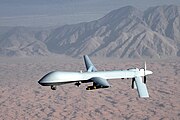History of radio § Broadcasting
Remote control
Radio remote control is the use of
electronic control signals sent by radio waves from a transmitter to
control the actions of a device at a remote location. Remote control systems
may also include telemetry channels in the other direction, used to
transmit real-time information of the state of the device back to the control
station. Unmanned spacecraft are an example of remote controlled
machines, controlled by commands transmitted by satellite ground stations. Most
handheld remote controls used to control consumer electronics products
like televisions or DVD players actually operate by infrared light rather
than radio waves, so are not examples of radio remote control. A security
concern with remote control systems is spoofing, in which an unauthorized person transmits an imitation of the
control signal to take control of the device. Examples of radio remote control:
·
Unamanned aerial vechicle (UAV, drone) – A drone is an
aircraft without an onboard pilot, flown by remote control by a pilot in
another location, usually in a piloting station on the ground. They are used by
the military for reconnaissance and ground attack, and more recently by the
civilian world for news reporting and aerial photography. The pilot uses
aircraft controls like a joystick or steering wheel, which create control
signals which are transmitted to the drone by radio to control the flight
surfaces and engine. A telemetry system
transmits back a video image from a camera in the drone to allow the pilot to
see where he is going, and data from a GPS receiver giving the
real-time position of the aircraft. UAVs have sophisticated on board automatic
pilot systems that maintain stable flight and only require manual control to
change directions.
Keyless
entry system – a short-range handheld battery powered key
fob transmitter, included with most modern cars, which can lock and unlock the
doors of a vehicle from outside, eliminating the need to use a key. When a button
is pressed, the transmitter sends a coded radio signal to a receiver in the
vehicle, operating the locks. The fob must be close to the vehicle, typically
within 5 to 20 meters. North America and Japan use a frequency of 315 MHz,
while Europe uses 433.92 and 868 MHz. Some models can also remotely start
the engine, to warm up the car. A security concern with all keyless entry
systems is a replay attack, in which a thief uses a special
receiver ("code grabber") to record the radio signal during opening,
which can later be replayed to open the door. To prevent this, keyless systems
use a rolling code system in which a pseudorandom number generator in the remote
control generates a different random key each time it is used. To prevent
thieves from simulating the pseudorandom generator to calculate the next key,
the radio signal is also encrypted.





Comments
Post a Comment